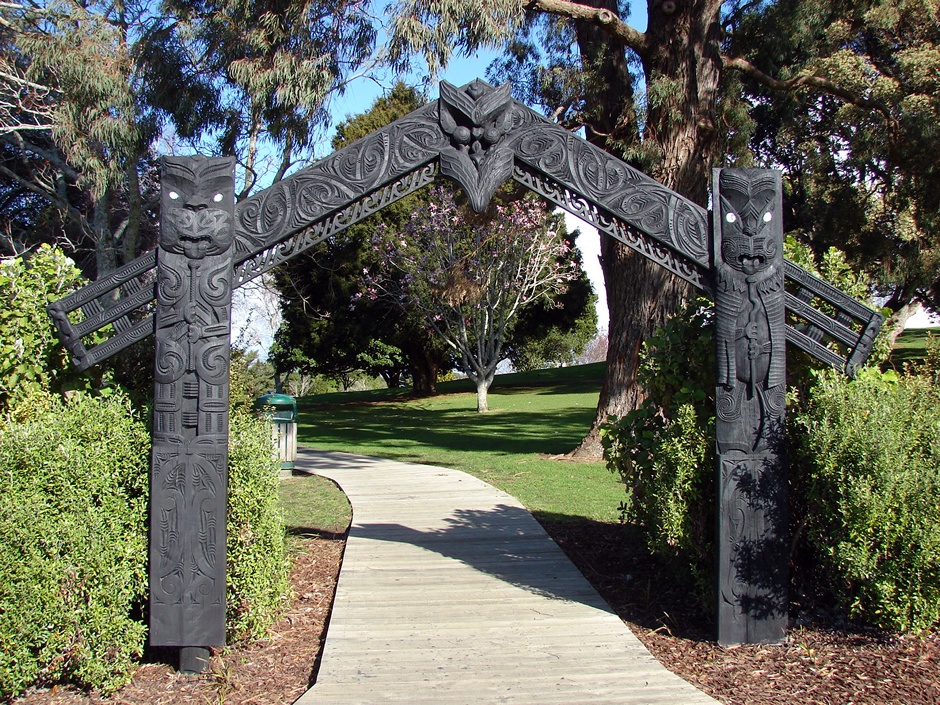
The Battle of Gate Pā (Pukehinahina), fought near Tauranga on 29 April 1864, was notable for the ferocity of the fighting, the repulse of the British forces, and an act of chivalry by one of the defenders, Hēni Te Kiri Karamū, who at some risk to her own life gave water to a dying British officer and other wounded men. There are several memorials to the participants in Mission Cemetery in Marsh St, Tauranga. These include the Tauranga 1st Waikato Militia NZ Wars memorial, Tauranga 43rd Regiment NZ Wars memorial, Tauranga Naval NZ Wars memorial, individual memorials to Hōri Ngātai and Rāwiri Puhirake, and the Tauranga Māori NZ Wars memorial.
The site was garrisoned by men of the 68th Regiment after the battle, and by the colonial Armed Constabulary in the late 1860s. In the 1870s the redoubt was abandoned, Cameron Rd was cut through the site, and the remaining trenches were filled in. In 1880, Canon Charles Jordan asked that part of the Gate Pa Domain be made available for an Anglican church that would be a memorial to the British officers and men who had fallen in the battle. Fundraising was undertaken and part of the pā site was obtained through an exchange of land between the government and the church. St George’s Memorial Church was opened on the site in 1900.
Between the world wars, there were several proposals to relocate the church and restore Gate Pā. Nothing came of these suggestions, and after the Second World War the remnants of the site diminished further when part of the reserve on the western side of Cameron Rd was used for sports facilities.
In 1964 the Tauranga Historical Society erected a memorial in the reserve. This was unveiled by Chief Justice Sir Harold Barrowclough and dedicated by the Reverend Brown Turei on the centennial of the battle. The memorial bore several plaques. One commemorated ‘the chivalry displayed by both Maori and Pakeha’ during the battle and another remembered ‘the unnamed Maori who were killed at this battle and buried here’. In fact, the Māori dead were buried on the other side of Cameron Rd, and as Nigel Prickett has shown, most of their names were recorded at the time.
On 29 April 2007 a carved tomokanga (gateway) was installed at the lower entrance to the reserve. This incorporated carvings of Tū, the god of war, and Rongo, the god of peace.
In 2014 members of the Pukehinahina Charitable Trust enlarged and embellished the memorial, adding a large deck (marae ātea) and replacing the old flagpole. Two trees flanking the memorial which were to have been removed were instead lopped and turned into carvings.
Eight carved pillars (pou) were installed along the edge of the reserve. Each pou stands for one of the main protagonists: Ngāi Te Rangi, Ngāti Ranginui, Ngāi Tamarāwaho, Ngāti Pūkenga, Ngāti Hangarau, Waitaha, Tainui iwi, and Pākehā (Lieutenant General Sir Duncan Cameron is depicted). The refurbished memorial was dedicated on 29 April 2014, the 150th anniversary of the battle.
Further information
- NZ Gazette, 1887, pp. 929, 1367
- ‘The Memorial’, Journal of the Tauranga Historical Society, no. 19, March 1964, pp. 33-6
- ‘Memorial Unveiled’, Bay of Plenty Times, 28 April 1964
- ‘Gate Pa Centennial Address’, Journal of the Tauranga Historical Society, no. 21, September 1964, pp. 3-7
- Pukehinahina: historic Gate Pa, 2nd edn, St George’s Memorial Church, Tauranga, 1968
- Chris Maclean and Jock Phillips, The sorrow and the pride: New Zealand war memorials, GP Books, Wellington, 1990, pp. 39-41
- W. Kennedy, ‘A Brief History of Greerton’, Historical Review, vol. 42, no. 1, May 1994, pp. 40-8
- Nigel Prickett, ‘Maori Casualties at Pukehinahina (Gate Pa), 29 April 1864’, Records of the Auckland Museum, vol. 41, 2004, pp. 37–52
- ‘Battle of Gate Pa Commemorations’, Bay of Plenty Times, 12 April 2014











Community contributions